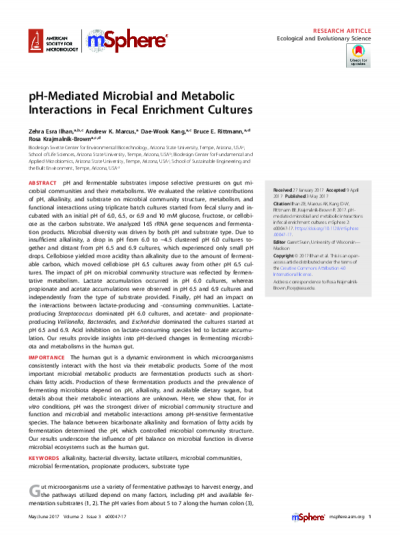

Syngas fermentation, the bioconversion of CO, CO[subscript 2], and H[subscript 2] to biofuels and chemicals, has undergone considerable optimization for industrial applications. Even more, full-scale plants for ethanol production from syngas fermentation by pure cultures are being built worldwide. The composition of syngas depends on the feedstock gasified and the gasification conditions. However, it remains unclear how different syngas mixtures affect the metabolism of carboxidotrophs, including the ethanol/acetate ratios. In addition, the potential application of mixed cultures in syngas fermentation and their advantages over pure cultures have not been deeply explored. In this work, the effects of CO[subscript 2] and H[subscript 2] on the CO metabolism by pure and mixed cultures were studied and compared. For this, a CO-enriched mixed culture and two isolated carboxidotrophs were grown with different combinations of syngas components (CO, CO:H[subscript 2], CO:CO[subscript 2], or CO:CO[subscript 2]:H[subscript 2]).
Results
The CO metabolism of the mixed culture was somehow affected by the addition of CO[subscript 2] and/or H[subscript 2], but the pure cultures were more sensitive to changes in gas composition than the mixed culture. CO[subscript 2] inhibited CO oxidation by the Pleomorphomonas-like isolate and decreased the ethanol/acetate ratio by the Acetobacterium-like isolate. H[subscript 2] did not inhibit ethanol or H[subscript 2] production by the Acetobacterium and Pleomorphomonas isolates, respectively, but decreased their CO consumption rates. As part of the mixed culture, these isolates, together with other microorganisms, consumed H[subscript 2] and CO[subscript 2] (along with CO) for all conditions tested and at similar CO consumption rates (2.6 ± 0.6 mmol CO L[superscript −1] day[superscript −1]), while maintaining overall function (acetate production). Providing a continuous supply of CO by membrane diffusion caused the mixed culture to switch from acetate to ethanol production, presumably due to the increased supply of electron donor. In parallel with this change in metabolic function, the structure of the microbial community became dominated by Geosporobacter phylotypes, instead of Acetobacterium and Pleomorphomonas phylotypes.
Conclusions
These results provide evidence for the potential of mixed-culture syngas fermentation, since the CO-enriched mixed culture showed high functional redundancy, was resilient to changes in syngas composition, and was capable of producing acetate or ethanol as main products of CO metabolism.

Anode-respiring bacteria (ARB) generate electric current in microbial electrochemical cells (MXCs) by channeling electrons from the oxidation of organic substrates to an electrode. Production of high current densities by monocultures in MXCs has resulted almost exclusively from the activity of Geobacter sulfurreducens, a neutrophilic freshwater Fe(III)-reducing bacterium and the highest-current-producing member documented for the Geobacteraceae family of the Deltaproteobacteria. Here we report high current densities generated by haloalkaliphilic Geoalkalibacter spp., thus broadening the capability for high anode respiration rates by including other genera within the Geobacteraceae. In this study, acetate-fed pure cultures of two related Geoalkalibacter spp. produced current densities of 5.0 to 8.3 and 2.4 to 3.3 A m-2 under alkaline (pH 9.3) and saline (1.7% NaCl) conditions, respectively. Chronoamperometric studies of halophilic Glk. subterraneus DSM 23483 and alkaliphilic Glk. ferrihydriticus DSM 17813 suggested that cells performed long-range electron transfer through electrode-attached biofilms and not through soluble electron shuttles. Glk. ferrihydriticus also oxidized ethanol directly to produce current, with maximum current densities of 5.7 to 7.1 A m-2 and coulombic efficiencies of 84 to 95%. Cyclic voltammetry (CV) elicited a sigmoidal response with characteristic onset, midpoint, and saturation potentials, while CV performed in the absence of an electron donor suggested the involvement of redox molecules in the biofilm that were limited by diffusion. These results matched those previously reported for actively respiring Gb. sulfurreducens biofilms producing similar current densities (~5 to 9 A m-2).

Syntrophic interactions between organohalide-respiring and fermentative microorganisms are critical for effective bioremediation of halogenated compounds. This work investigated the effect of ammonium concentration (up to 4 g liter-1 NH4+-N) on trichloroethene-reducing Dehalococcoides mccartyi and Geobacteraceae in microbial communities fed lactate and methanol. We found that production of ethene by D. mccartyi occurred in mineral medium containing ≤2 g liter-1 NH4+-N and in landfill leachate. For the partial reduction of trichloroethene (TCE) to cis-dichloroethene (cis-DCE) at ≥1 g liter-1 NH4+-N, organohalide-respiring dynamics shifted from D. mccartyi and Geobacteraceae to mainly D. mccartyi. An increasing concentration of ammonium was coupled to lower metabolic rates, longer lag times, and lower gene abundances for all microbial processes studied. The methanol fermentation pathway to acetate and H2 was conserved, regardless of the ammonium concentration provided. However, lactate fermentation shifted from propionic to acetogenic at concentrations of ≥2 g liter-1 NH4+-N. Our study findings strongly support a tolerance of D. mccartyi to high ammonium concentrations, highlighting the feasibility of organohalide respiration in ammonium-contaminated subsurface environments.

We sequenced and annotated genomes of two haloalkaliphilic Deltaproteobacteria, Geoalkalibacter ferrihydriticus Z-0531T (DSM 17813) and Geoalkalibacter subterraneus Red1T (DSM 23483). During assembly, we discovered that the DSMZ stock culture of G. subterraneus was contaminated. We reisolated G. subterraneus in axenic culture and redeposited it in DSMZ and JCM.

Modern software applications are commonly built by leveraging pre-fabricated modules, e.g. application programming interfaces (APIs), which are essential to implement the desired functionalities of software applications, helping reduce the overall development costs and time. When APIs deal with security-related functionality, it is critical to ensure they comply with their design requirements since otherwise unexpected flaws and vulnerabilities may consequently occur. Often, such APIs may lack sufficient specification details, or may implement a semantically-different version of a desired security model to enforce, thus possibly complicating the runtime enforcement of security properties and making it harder to minimize the existence of serious vulnerabilities. This paper proposes a novel approach to address such a critical challenge by leveraging the notion of software assertions. We focus on security requirements in role-based access control models and show how proper verification at the source-code level can be performed with our proposed approach as well as with automated state-of-the-art assertion-based techniques.

Background: Autism spectrum disorders (ASD) are complex neurobiological disorders that impair social interactions and communication and lead to restricted, repetitive, and stereotyped patterns of behavior, interests, and activities. The causes of these disorders remain poorly understood, but gut microbiota, the 1013 bacteria in the human intestines, have been implicated because children with ASD often suffer gastrointestinal (GI) problems that correlate with ASD severity. Several previous studies have reported abnormal gut bacteria in children with ASD. The gut microbiome-ASD connection has been tested in a mouse model of ASD, where the microbiome was mechanistically linked to abnormal metabolites and behavior. Similarly, a study of children with ASD found that oral non-absorbable antibiotic treatment improved GI and ASD symptoms, albeit temporarily. Here, a small open-label clinical trial evaluated the impact of Microbiota Transfer Therapy (MTT) on gut microbiota composition and GI and ASD symptoms of 18 ASD-diagnosed children.
Results: MTT involved a 2-week antibiotic treatment, a bowel cleanse, and then an extended fecal microbiota transplant (FMT) using a high initial dose followed by daily and lower maintenance doses for 7–8 weeks. The Gastrointestinal Symptom Rating Scale revealed an approximately 80% reduction of GI symptoms at the end of treatment, including significant improvements in symptoms of constipation, diarrhea, indigestion, and abdominal pain. Improvements persisted 8 weeks after treatment. Similarly, clinical assessments showed that behavioral ASD symptoms improved significantly and remained improved 8 weeks after treatment ended. Bacterial and phage deep sequencing analyses revealed successful partial engraftment of donor microbiota and beneficial changes in the gut environment. Specifically, overall bacterial diversity and the abundance of Bifidobacterium, Prevotella, and Desulfovibrio among other taxa increased following MTT, and these changes persisted after treatment stopped (followed for 8 weeks).
Conclusions: This exploratory, extended-duration treatment protocol thus appears to be a promising approach to alter the gut microbiome and virome and improve GI and behavioral symptoms of ASD. Improvements in GI symptoms, ASD symptoms, and the microbiome all persisted for at least 8 weeks after treatment ended, suggesting a long-term impact.

High proportions of autistic children suffer from gastrointestinal (GI) disorders, implying a link between autism and abnormalities in gut microbial functions. Increasing evidence from recent high-throughput sequencing analyses indicates that disturbances in composition and diversity of gut microbiome are associated with various disease conditions. However, microbiome-level studies on autism are limited and mostly focused on pathogenic bacteria. Therefore, here we aimed to define systemic changes in gut microbiome associated with autism and autism-related GI problems. We recruited 20 neurotypical and 20 autistic children accompanied by a survey of both autistic severity and GI symptoms. By pyrosequencing the V2/V3 regions in bacterial 16S rDNA from fecal DNA samples, we compared gut microbiomes of GI symptom-free neurotypical children with those of autistic children mostly presenting GI symptoms. Unexpectedly, the presence of autistic symptoms, rather than the severity of GI symptoms, was associated with less diverse gut microbiomes. Further, rigorous statistical tests with multiple testing corrections showed significantly lower abundances of the genera Prevotella, Coprococcus, and unclassified Veillonellaceae in autistic samples. These are intriguingly versatile carbohydrate-degrading and/or fermenting bacteria, suggesting a potential influence of unusual diet patterns observed in autistic children. However, multivariate analyses showed that autism-related changes in both overall diversity and individual genus abundances were correlated with the presence of autistic symptoms but not with their diet patterns. Taken together, autism and accompanying GI symptoms were characterized by distinct and less diverse gut microbial compositions with lower levels of Prevotella, Coprococcus, and unclassified Veillonellaceae.